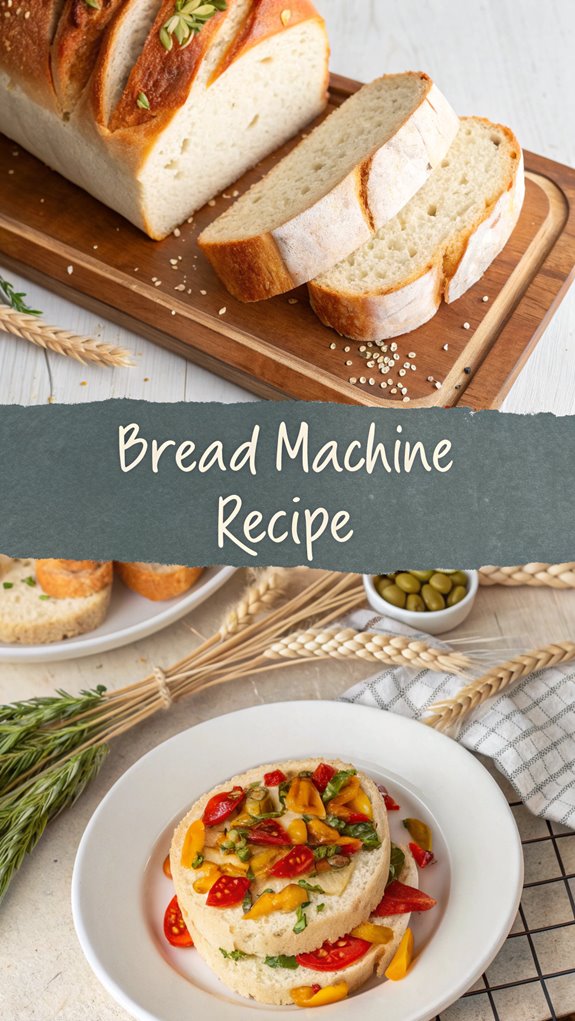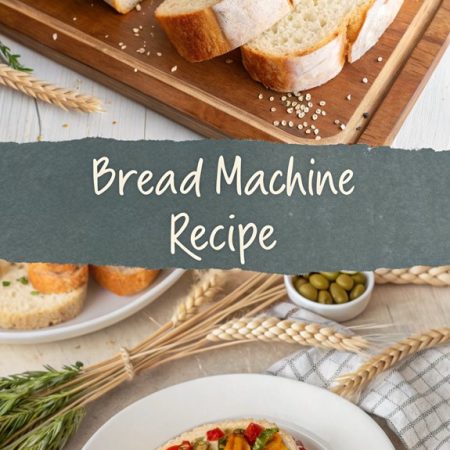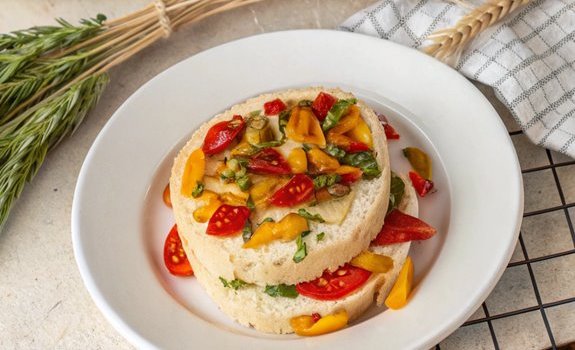Bread Machine Recipe White
If you want to make white bread in your bread machine, gather these ingredients: 1 ½ cups milk (room temperature), 1 ½ tsp salt, 2 tbsp sugar, 2 tbsp butter, 3 ½ cups all-purpose flour, and 1 ½ tsp yeast. Start by measuring the ingredients accurately and add them to the machine in the correct order, usually liquid first, followed by dry. Create a small indentation in the flour for the yeast. Select the Basic or White Bread Cycle and set your crust preference. After baking, cool your bread on a wire rack for 20-30 minutes before slicing. More tips await to enhance your bread-making skills.
Key Takeaways
- Use 1 1/2 cups of room temperature milk, 2 tbsp sugar, and 1 1/2 tsp salt for a flavorful white bread base.
- Layer ingredients in the bread machine according to the manufacturer’s instructions for optimal results.
- Add 3 1/2 cups of all-purpose flour and 1 1/2 tsp of yeast to create the perfect dough texture.
- Select the Basic or White Bread Cycle and set the crust preference to Medium for a balanced bake.
- Allow the bread to cool on a wire rack for 20-30 minutes before slicing to enhance its flavor and texture.
Why You’ll Love this Recipe
When you think of the perfect loaf of bread, this bread machine recipe is sure to impress.
You’ll love how easy it’s to create fresh, homemade bread with minimal effort. Here are some benefits you’ll appreciate:
- Time-Saving: Just add ingredients and press a button.
- Control Over Ingredients: You can avoid preservatives and chemicals.
- Versatility: Make various bread types like whole grain or gluten-free.
- Nutritious: Homemade bread is tastier and healthier than store-bought options, allowing you to control over ingredients for a healthier diet.
Using a bread machine is practical and fun.
Your home fills with the delightful aroma of baking bread, and it’s less messy than traditional methods.
Plus, it’s a great way to engage your family in the kitchen.
Enjoy making delicious bread with this simple recipe!
Recipe

Making bread in a bread machine is a straightforward and rewarding process that yields delicious homemade loaves with minimal effort. The machine takes care of the kneading and rising, allowing you to focus on the joy of baking without the usual hassle. This recipe produces a soft, flavorful bread that’s perfect for sandwiches, toast, or simply enjoying with a pat of butter. Additionally, using a bread machine provides consistent results with minimal effort, making it an ideal choice for everyday baking.
Before you get started, gather all your ingredients and ensure they’re at room temperature for the best results. Using the right proportions and following the machine’s settings will help you achieve a perfect loaf. Whether you’re a seasoned baker or a beginner, this recipe is designed to be easy to follow and will deliver delightful results.
Ingredients:
– 1 1/2 cups milk (at room temperature)
– 1 1/2 tsp salt
– 2 tbsp granulated sugar
– 2 tbsp butter
– 3 1/2 cups all-purpose flour
– 1 1/2 teaspoons instant or active dry yeast
Cooking Instructions:
1. Begin by measuring out all of your ingredients carefully. Aerate the flour to ensure accurate measurement, then place it in the bread machine’s pan.
- Add the milk, salt, sugar, and butter to the pan in the order recommended by the manufacturer. Make sure to keep the yeast away from the salt.
- Create a small indentation in the flour and add the yeast to this spot. This helps to prevent the yeast from activating too early.
- Select the Basic or White Bread Cycle on your bread machine, and set the crust preference to Medium. Ensure that your machine’s capacity is suitable for this recipe (1 1/2 to 2 pounds).
- Start the machine and let it knead and rise the dough during the basic cycle, which will take about 3 hours.
- Once the cycle is complete, carefully remove the bread pan from the machine and let the bread cool on a wire rack for at least 20-30 minutes before slicing.
For best results, make sure to use lukewarm ingredients, as they promote better yeast activity. Avoid overloading your bread machine to ensure an even rise.
Additionally, if you prefer a different flavor or texture, consider experimenting with variations of liquid ingredients, flour types, or fats. Always store your cooled bread in a bread box or bag to maintain freshness. Happy baking!
Final Thoughts
As you wrap up your bread-making journey, remember that each loaf is a learning experience. Here are some final troubleshooting tips to ensure success:
- Check Ingredient Ratios: Too much liquid or salt can ruin your loaf. Use the right amount of sugar and flour for proper yeast activation.
- Quality Matters: Fresh yeast and the correct flour type are key. Measure ingredients accurately to avoid overload. Old yeast can significantly hinder the rising process, so always verify its viability before use.
- Watch Your Machine: Keep an eye on the knead bar and ensure the pan is clean. Be mindful of the liquid temperature and avoid power interruptions.
- Learn and Adjust: Observe your dough, make small recipe adjustments, and review your steps. Proper ingredient handling can significantly improve your outcomes.
Happy baking!
Frequently Asked Questions
Can I Use Whole Wheat Flour Instead of White Flour?
Yes, you can use whole wheat flour instead of white flour. Just remember to adjust the liquid, allow the dough to rest, and consider using a blend for lighter, softer results. Enjoy experimenting!
How Do I Store Leftover Bread?
Like a treasure waiting to be preserved, store your leftover bread in a bread box or wrap it in a tea towel. If longer storage is needed, freeze it for future enjoyment without losing freshness.
Can I Add Herbs or Spices to the Dough?
Yes, you can definitely add herbs or spices to the dough! Just make sure to balance the quantities, using high-quality ingredients. Mixing them into the flour will enhance the flavor of your bread. Enjoy experimenting!
What Size Bread Machine Is Best for This Recipe?
Did you know that nearly 70% of households prefer a 1.5 lb bread machine for versatility? For your recipe, choose a machine that matches the loaf size to ensure successful baking and prevent overflow.
How Can I Troubleshoot Dense Bread?
To troubleshoot dense bread, check your yeast freshness, measure ingredients accurately, and avoid overmixing. Ensure proper proofing times and maintain adequate oven temperatures. Use high-gluten flour for better gas retention and structure.

Bread Machine Recipe White
Ingredients
- - 1 1/2 cups milk at room temperature
- - 1 1/2 tsp salt
- - 2 tbsp granulated sugar
- - 2 tbsp butter
- - 3 1/2 cups all-purpose flour
- - 1 1/2 teaspoons instant or active dry yeast
Instructions
- Begin by measuring out all of your ingredients carefully. Aerate the flour to ensure accurate measurement, then place it in the bread machine's pan.
- Add the milk, salt, sugar, and butter to the pan in the order recommended by the manufacturer. Make sure to keep the yeast away from the salt.
- Create a small indentation in the flour and add the yeast to this spot. This helps to prevent the yeast from activating too early.
- Select the Basic or White Bread Cycle on your bread machine, and set the crust preference to Medium. Ensure that your machine's capacity is suitable for this recipe (1 1/2 to 2 pounds).
- Start the machine and let it knead and rise the dough during the basic cycle, which will take about 3 hours.
- Once the cycle is complete, carefully remove the bread pan from the machine and let the bread cool on a wire rack for at least 20-30 minutes before slicing.
- For best results, make sure to use lukewarm ingredients, as they promote better yeast activity. Avoid overloading your bread machine to ensure an even rise.
- Additionally, if you prefer a different flavor or texture, consider experimenting with variations of liquid ingredients, flour types, or fats. Always store your cooled bread in a bread box or bag to maintain freshness. Happy baking!


